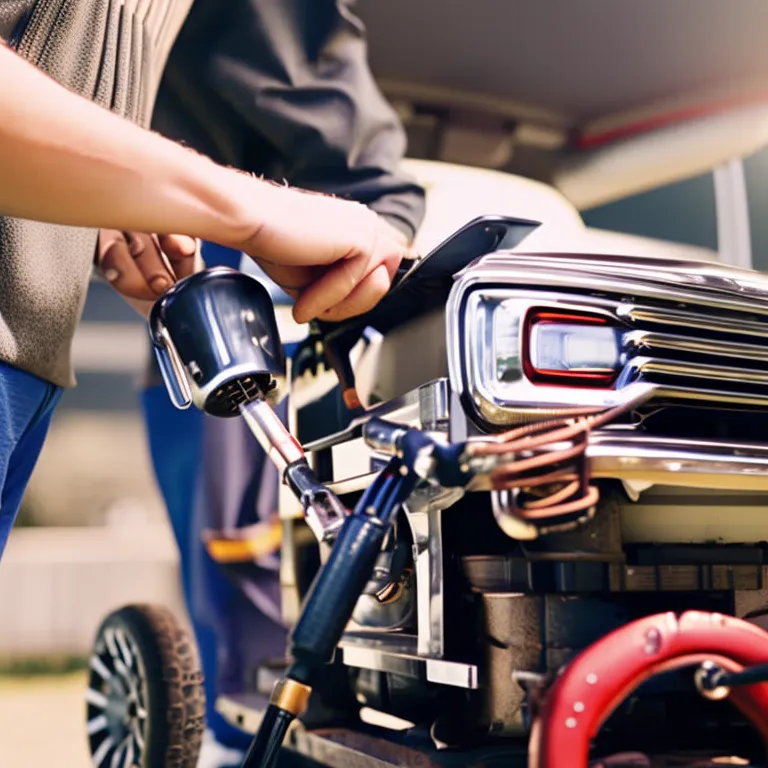Revive Your Golf Cart: Starter Generator Troubleshooting
Are you tired of struggling to start your golf cart or hearing strange noises when you turn the key? Don’t worry, you’re not alone. Many golf cart owners experience problems with their starter generators, but the good news is that troubleshooting and repairing these issues can be a simple and cost-effective solution.
- Revive Your Golf Cart: Starter Generator Troubleshooting
- Key Takeaways
- Common Problems
- Removal and Testing
- Repair and Replacement
- Frequently Asked Questions
- How often should starter generators be replaced in golf carts?
- Can starter generators be repaired instead of replaced?
- Are there any safety precautions that should be taken when removing or testing a starter generator?
- Can using the wrong replacement parts cause damage to the golf cart?
- Are there any maintenance tasks that can prevent starter generator issues from occurring in the first place?
With a little bit of knowledge and some basic tools, you can revive your golf cart and get back to cruising around the course or retirement community in no time.
In this article, we will guide you through the process of starter generator troubleshooting, including common problems, removal and testing, and repair and replacement. We understand how important your golf cart is to you and how frustrating it can be when it doesn’t work properly.
That’s why we’ve created this guide to help you get your cart up and running again, so you can enjoy your favorite pastime or get around your community with ease.
So, let’s dive in and revive your golf cart!
Key Takeaways
– Troubleshooting and repairing starter generator issues can prevent costly repairs or replacements down the line.
– Bench testing the starter generator can identify up to 90% of issues.
– Repairing or replacing the starter generator requires the right tools and replacement parts, including brushes, voltage regulator, solenoid, and control system.
– Regular maintenance is important, including using compressed air to remove debris before reassembling.
Common Problems
If you’re having trouble starting your golf cart or notice any strange noises or flickering lights, it’s possible that your starter generator is experiencing wear and tear. Common issues include dead spots, frayed cables, and ticking in the controller box. These problems can affect the effectiveness of your starter generator and make it difficult to start your cart smoothly.
Another symptom of starter generator issues is a longer turn over time. If your golf cart takes longer than usual to start, it’s possible that your starter generator is struggling to provide enough power to the starter. These common problems can often be fixed through troubleshooting and repairing or replacing damaged components.
Avoid costly repairs or replacement of the engine by addressing these issues as soon as possible.
Removal and Testing
To remove and test the starter generator, you’ll need basic tools and equipment. First, disconnect the negative battery cable to prevent electrical shocks.
Then, remove the bolts and wires that connect the starter generator to the cart. Once removed, you can bench test the starter generator using battery jumper cables, wire, a working battery, and a vice. This will help identify up to 90% of starter generator issues.
Here are three reasons why it’s important to remove and test your golf cart’s starter generator:
1. It can save you money: Troubleshooting your starter generator can prevent costly repairs or replacements down the line.
2. It ensures smooth operation: A properly functioning starter generator ensures that your cart starts smoothly every time.
3. It’s part of regular maintenance: Just like changing the oil or checking the brakes, removing and testing the starter generator should be a routine part of maintenance for your golf cart.
Repair and Replacement
When repairing or replacing the starter generator on your golf cart, it’s important to have the right tools and replacement parts based on the manufacturer. If you’re repairing the generator yourself, you’ll need to unscrew the screws and clean or replace the brushes. Make sure to use compressed air to remove any debris before reassembling. For replacement, head to a golf cart shop and provide them with the make and model of your cart to ensure compatibility.
In addition to replacing the starter generator, you may need to rewire the system. This process varies for each cart model, so consult the manufacturer’s manual or seek professional help if unsure. To help you navigate the replacement and rewiring process, we’ve created a table below outlining common replacement parts and their function. With the right tools and knowledge, you can revive your golf cart and get back on the course in no time.
| Replacement Part | Function |
|---|---|
| Starter Generator | Provides power to the starter for smooth operation |
| Brushes | Transfers electricity to the rotor |
| Voltage Regulator | Maintains a consistent voltage |
| Solenoid | Acts as an electrical switch |
| Control System | Ensures battery doesn’t use too much electricity |
Remember, troubleshooting and repairing your golf cart can save you money and prevent further damage. Don’t be afraid to seek professional help if you’re unsure or uncomfortable with the process. With a little effort, you can give your golf cart a new lease on life and enjoy many more rounds on the course.
Frequently Asked Questions
How often should starter generators be replaced in golf carts?
Starter generators in golf carts typically last for several years, but the lifespan can vary depending on usage and maintenance. If you notice symptoms of wear and tear, such as difficulty starting or strange noises, it may be time for a replacement.
Can starter generators be repaired instead of replaced?
Yes, starter generators can be repaired instead of replaced. The repair process may involve bench testing, replacing generator brushes, and rewiring. Seeking professional help is recommended if unsure of the process.
Are there any safety precautions that should be taken when removing or testing a starter generator?
Removing or testing a golf cart starter generator is like handling a delicate flower that needs protection. Before proceeding, disconnect the negative battery cable, wear gloves, and ensure the area is well-ventilated. Seek professional help if unsure.
Can using the wrong replacement parts cause damage to the golf cart?
Using the wrong replacement parts for your golf cart can cause damage. It’s important to find parts that are compatible with your specific make and model. Seek professional help if unsure.
Are there any maintenance tasks that can prevent starter generator issues from occurring in the first place?
Prevent starter generator issues by regularly checking cables and connections for wear and tear. Keep the generator clean and free of debris. Properly maintain and charge the battery. Follow manufacturer’s recommended maintenance schedule.




